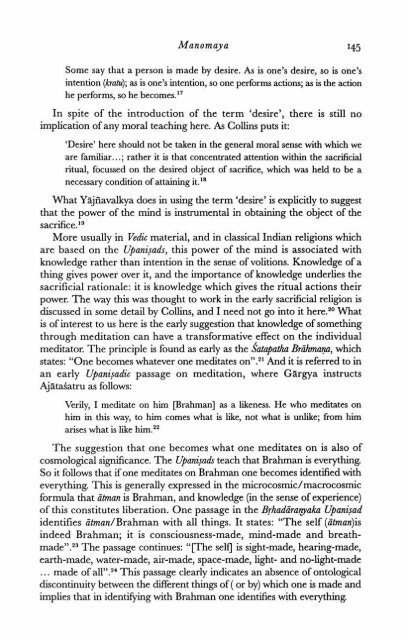Identity and Experience_Hamilton_1996
Identity and Experience_Hamilton_1996
Identity and Experience_Hamilton_1996
Create successful ePaper yourself
Turn your PDF publications into a flip-book with our unique Google optimized e-Paper software.
Manomaya<br />
I45<br />
Some say that a person is made by desire. As is one's desire, so is one's<br />
intention (kratu); as is one's intention, so one performs actions; as is the action<br />
he performs, so he becomes."<br />
In spite of the introduction of the term 'desire', there is still no<br />
implication of any moral teaching here, As Collins puts it:<br />
'Desire' here should not be taken in the general moral sense with which we<br />
are familiar.. .; rather it is that concentrated attention within the sacrificial<br />
ritual, focussed on the desired object of sacrifice, which was held to be a<br />
necessary condition of attaining it.''<br />
What Yajfiavalkya does in using the term 'desire' is explicitly to suggest<br />
that the power of the mind is instrumental in obtaining the object of the<br />
sacrifice. lg<br />
More usually in Vedic material, <strong>and</strong> in classical Indian religions which<br />
are based on the Upani;ads, this power of the mind is associated with<br />
knowledge rather than intention in the sense of volitions. Knowledge of a<br />
thing gives power over it, <strong>and</strong> the importance of knowledge underlies the<br />
sacrificial rationale: it is knowledge which gives the ritual actions their<br />
power. The way this was thought to work in the early sacrificial religion is<br />
discussed in some detail by Collins, <strong>and</strong> I need not go into it here.20 What<br />
is of interest to us here is the early suggestion that knowledge of something<br />
through meditation can have a transformative effect on the individual<br />
meditator. The principle is found as early as the Satapatha Briihmapz, which<br />
states: "One becomes whatever one meditates on".21 And it is referred to in<br />
an early Upani;adic passage on meditation, where Gargya instructs<br />
AjataSatru as follows:<br />
Verily, I meditate on him [Brahman] as a likeness. He who meditates on<br />
him in this way, to him comes what is like, not what is unlike; from him<br />
arises what is like him.22<br />
The suggestion that one becomes what one meditates on is also of<br />
cosmological significance. The UpanGalis teach that Brahman is everything.<br />
So it follows that if one meditates on Brahman one becomes identified with<br />
everything. This is generally expressed in the microcosmic/rnacrocosrnic<br />
formula that &an is Brahman, <strong>and</strong> knowledge (in the sense of experience)<br />
of this constitutes liberation. One passage in the Byhadtiragaka Upani~ad<br />
identifies Ztman/Brahman with all things. It states: "The self (5tman)is<br />
indeed Brahman; it is consciousness-made, mind-made <strong>and</strong> breathmade".23<br />
The passage continues: "[The self] is sight-made, hearing-made,<br />
earth-made, water-made, air-made, space-made, light- <strong>and</strong> no-light-made<br />
. . . made of all".24 This passage clearly indicates an absence of ontological<br />
discontinuity between the different things of ( or by) which one is made <strong>and</strong><br />
implies that in identifjring with Brahman one identifies with everything.


